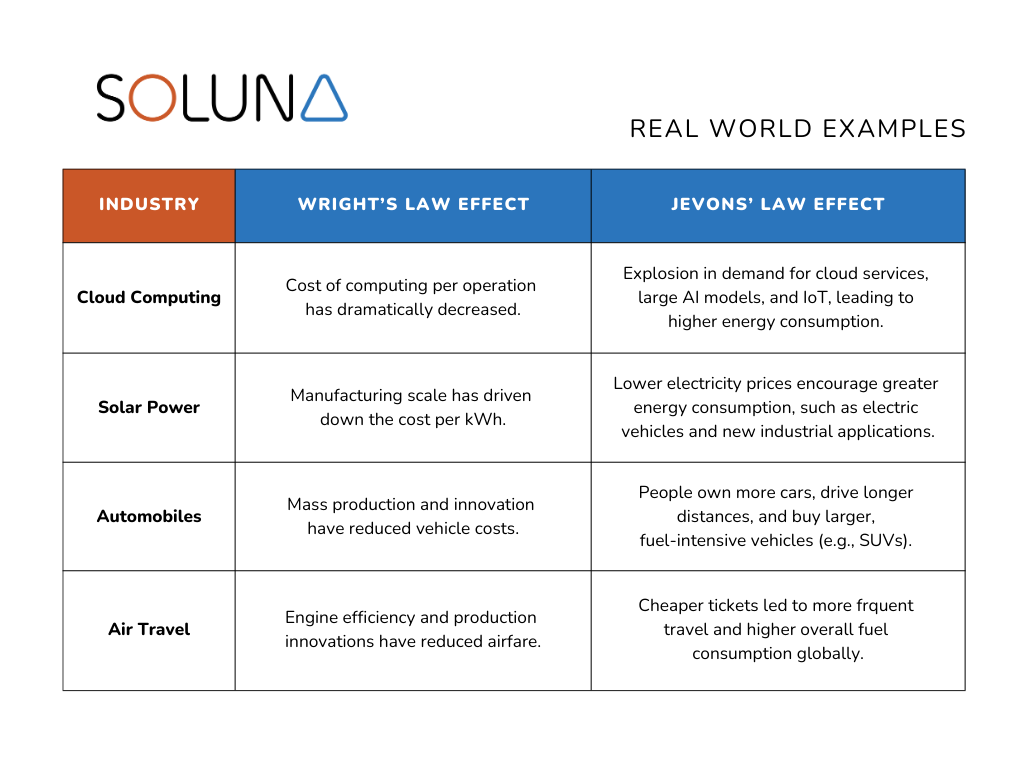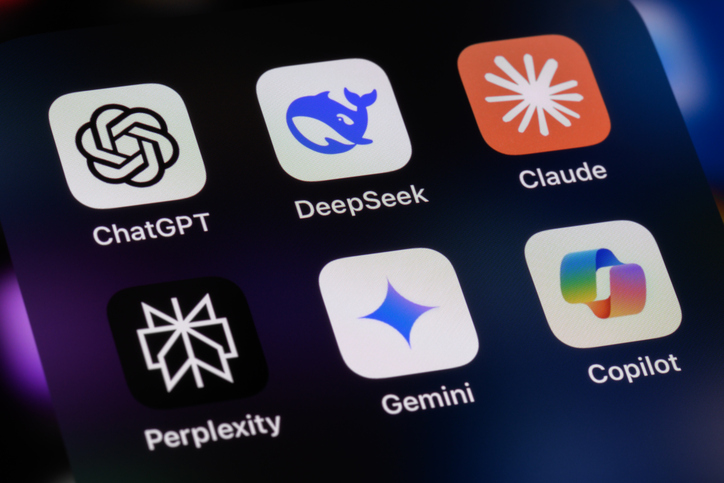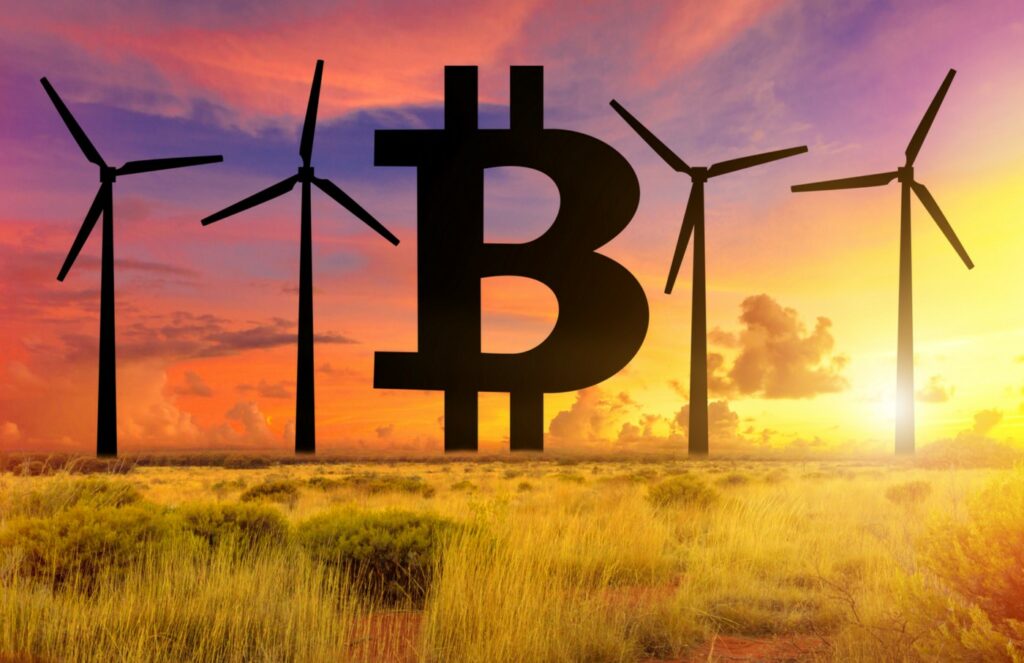AI is evolving at breakneck speed, and DeepSeek is the latest force shaking things up. At Soluna, we don’t just see this as another AI breakthrough—we see it as a catalyst for an even bigger shift: the explosive growth of AI infrastructure and the skyrocketing demand for energy.
This isn’t just about efficiency gains. It’s about the economic forces that turn every breakthrough into a surge in demand. Two key principles—Jevons Paradox and Wright’s Law—prove that making AI models and hardware more efficient doesn’t curb resource consumption. Instead, it can drive even greater use, accelerating the need for more data centers, more computing power, and most critically, more sustainable energy solutions.
The Economic Forces Behind AI’s Expansion
The relationship between technological efficiency and resource consumption is well-documented.
When LEDs were introduced there was a view that electricity consumption would drop precipitously. It didn’t.
LEDs are significantly more energy-efficient than traditional incandescent bulbs, consuming about 70-80% less electricity. This efficiency has led to widespread adoption, with LEDs replacing incandescent and fluorescent lights in both commercial and residential settings. However, instead of decreasing overall energy consumption, the reduced cost and increased efficiency of LED lighting have led to more extensive use. For instance, the proliferation of outdoor lighting products and the trend of homes being extensively lit during festive seasons have contributed to increased energy use.
This phenomenon aligns with Jevons’ Paradox, where improvements in energy efficiency lead to increased, rather than decreased, energy consumption.
So, as AI models become more efficient and computing power per watt improves, the cost of training and inference declines. This reduction, rather than dampening demand, will likely fuel further AI development and deployment, leading to an exponential rise in AI-driven applications. Wright’s Law, on the other hand, asserts that with each cumulative doubling of production, costs tend to decline at a predictable rate. As AI model training and inference become more sophisticated and scalable, cloud infrastructure must grow to accommodate the increasing demand for power and computational capacity.
The combination of these two economic principles ensures that efficiency gains in AI will not slow down infrastructure expansion. It will likely accelerate it, necessitating a transition to greener energy solutions to keep pace with demand and our climate goals.

Figure 1: Real-World Examples of the Relationship Between Wright and Jevons
The DeepSeek Phenomenon
DeepSeek is more than just another AI breakthrough—it marks a fundamental shift in the industry.
It’s indelible.
That’s the word that describes something so powerful or impactful that it leaves a permanent mark on your memory or perception, forever altering how you see the world.
What’s indelible about the DeepSeek phenomenon is this:
AI’s march towards ubiquity just became unstoppable. No longer is cutting-edge AI development limited to tech giants with deep pockets. Smaller, more agile teams now can create powerful models that address some of humanity’s most pressing challenges.
This democratization of AI mirrors the rise of personal computing in the early Internet era. What once required massive mainframes is now accessible to the masses. Similarly, DeepSeek signals a future where AI isn’t confined to elite research labs—it will soon be running on devices and applications worldwide.
But with this newfound accessibility comes an undeniable paradox. As AI becomes more efficient and widely available, its total energy consumption will increase—not decrease. Just as Jevons observed during the Industrial Revolution, greater efficiency leads to greater overall demand. The more we optimize AI, the more applications we discover, and the more compute we require.
The implications are clear:
- AI’s growth will demand exponentially more computing power.
- That computing power will require a massive expansion in energy consumption.
- To sustain this trajectory, we must find scalable, clean energy solutions.
- The integration of AI infrastructure and renewable energy is no longer optional—it’s imperative.
At Soluna, we have spent the past seven years preparing for this moment. Our mission has always been to harness renewable energy as a catalyst for computing power.
It’s Renewable Computing.
AI is that kind of computing, and its future depends on sustainable infrastructure.
The industry is at an inflection point. What happens next will define the future of AI and energy. One thing is certain: we cannot afford to ignore what’s coming.
What Soluna’s Advisor, Dan Golding, Has to Say
To provide deeper insight into this phenomenon, we spoke to Dan Golding, Chief Technology Officer at Appleby Strategy Group and valued member of Soluna’s Advisory Board, who recently shared his perspective on the AI market’s latest developments:
The last several days have seen financial markets and pundits losing their collective minds over several recent AI developments, especially the DeepSeek training announcements and, to a lesser degree, Alibaba’s Qwen AI model. TL;DR people need to calm down – this is a long haul, not a get-rich-quick scheme – at least for most of us. If you are, however, engaged in a short-term liquidity hunt and this situation has terminally shaken your confidence due to doom-scrolling on CNN, perhaps it’s time to find your next grift…uh, I mean career. The rest of us will somehow recover from your departure, I assure you.
NVIDIA was riding a bubble and everyone knew it. NVIDIA’s valuation was buoyed by largely unsustainable proclamations around their ability to ship new generations of chips and machine racks. Jensen is pushing too hard and the tech press has been too soft in their analysis. This was an inevitable adjustment and one that should have occurred long before now. That being said…
Are the DeepSeek developments fake or real? Well, likely a little of both. The training gains are, in reality, likely to produce about 30% increased efficiency. That doesn’t mean we need 30% fewer chips or data centers, it means we get 30% more power. Goldman Sachs has lamented that AI isn’t delivering enough ROI – well, this increases the gain significantly. There is a logical fallacy in IT, that a 10% efficiency gain means 10% less data center and 10% less server machines. And yet, that has been repeatedly disproven.
In economics, the Jevons paradox occurs when technological advancements make a resource more efficient to use (thereby reducing the amount needed for a single application); however, as the cost of using the resource drops, overall demand increases causing total resource consumption to rise. Governments, financial institutions, and journalists have typically expected efficiency gains to lower resource consumption, rather than anticipating possible increases due to the Jevons paradox – they’ve been proven wrong, repeatedly. Dario Amodei and Satya Nadella have both noted the applicability of Jevons to AI.
The Future of AI Cloud Growth and Renewable Energy Demand
DeepSeek’s advancements highlight a broader industry shift—AI’s efficiency improvements are fueling, not curbing, demand for cloud infrastructure. As AI models become more efficient and accessible, they unlock new applications, driving an insatiable need for computing power.
Jevons Paradox proves that efficiency gains lead to greater consumption, and AI is no exception. The more capable and cost-effective AI becomes, the more industries will integrate it, intensifying the need for scalable infrastructure and sustainable energy.
At Soluna, we see this as a defining moment. The world is shifting toward inference-driven AI, and infrastructure must evolve to meet its growing energy needs. The next wave of AI will be powered by scalable, sustainable solutions—those who align AI with clean energy will shape the future of technology.




